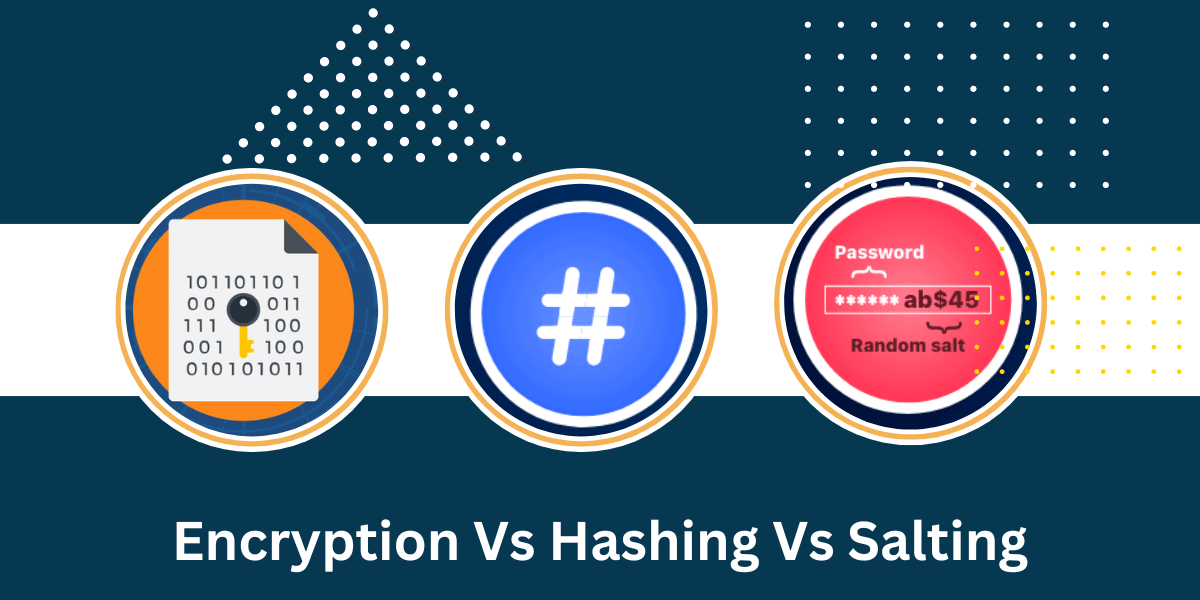What is the Difference Between Encryption and Hashing and Salting
With data breaches and hacking attacks on the rise, protecting sensitive information has become crucial. Three key techniques used to secure data are encryption, hashing, and salting. But what exactly is the difference between them?
Encryption, hashing, and salting are all related techniques but serve different purposes. Understanding how they work and when to use each one is important for properly securing systems and data.
This article will provide an in-depth overview of encryption, hashing, and salting. We’ll cover what each technique does, how it works, use cases, and the main differences. By the end, you’ll have a solid understanding of these critical data security concepts.
Key Takeaways
- Encryption transforms data into ciphertext that can only be decrypted with a key. It protects data confidentiality.
- Hashing creates a fixed-length digest of data that cannot be reversed. It is used to verify data integrity.
- Salting adds random data to hashes to prevent rainbow table attacks. It strengthens hashed passwords.
- Encryption provides confidentiality, hashing provides integrity, salting strengthens hashed data security.
- Encryption is two-way, hashing is one-way. Hashed data cannot be decrypted like encrypted data.
- Salting hashes before storing makes cracking much harder even if the hash is obtained.
Head-to-Head Comparison Between Encryption Vs Hashing Vs Salting
| Feature | Encryption | Hashing | Salting |
| Process | Two-way | One-way | Strengthens hashing |
| Purpose | Confidentiality | Integrity | Enhanced security |
| Input | Plaintext | Any data | Hash + salt |
| Output | Ciphertext | Hash value | Salted hash |
| Reversible | Yes, with key | No | No |
| Use Case | Secure data storage/transmission | Verify data integrity | Hash passwords or sensitive data |
| Requires Key | Yes | No | No |
| Requires Salt | No | No | Yes |
| Algorithm Examples | AES, RSA | MD5, SHA-256 | N/A |
| Collision Resistance | Yes | Can have collisions | No collisions |
| Rainbow Table Resistance | Yes | No | Yes |
| Ciphertext Size | Varies | Fixed | Fixed |
| Common Uses | Encrypted disks/data, HTTPS, VPNs | File integrity, digital signatures | Password hashing |
| Storage Requirements | Store ciphertext + key | Store hash | Store hash + salt |
| Vulnerabilities | Weak algorithms, stolen keys | Collision attacks | Rainbow table attacks on hashes |
What is Encryption?
Encryption is the process of encoding data in such a way that only authorized parties can access it. The original data, referred to as plaintext, is encrypted into ciphertext that looks like meaningless gibberish to unauthorized viewers.
Encrypted data can be decrypted back into plaintext for authorized users with the proper decryption key. This provides confidentiality by ensuring only those with the key can read the message.
Some key aspects of encryption:
- Two-way process: Data can be encrypted and decrypted.
- Confidentiality: Converts data into unreadable ciphertext.
- Uses algorithms and keys: Encryption algorithms combine the plaintext data with a key to create the ciphertext.
- Authorized access: Only those with the right decryption key can access the plaintext.
Encryption is used to protect sensitive data like passwords, credit card details, trade secrets, and classified information. Top examples include:
- Secure websites use HTTPS encryption.
- Messaging apps like WhatsApp encrypt messages and calls.
- Full disk encryption transforms hard drive data into ciphertext.
- Database encryption protects sensitive fields like passwords.
What is Hashing?
Hashing is the transformation of data into a fixed-length string output called a hash value or hash. It differs from encryption in several keyways:
- One-way process: Data cannot be reversed from hashes.
- Integrity verification: Hashes verify data has not changed.
- Uses hash algorithms: Common ones are MD5, SHA-1 and SHA-256.
- Same input = same hash: Identical data always produces the same unique hash.
- Different inputs ≠ same hash: Different data results in different hashes.
Hashing is implemented in several areas:
- Password storage: Passwords are hashed instead of stored in plaintext.
- Data integrity: Hashes verify files, drives, or data transmissions weren’t altered.
- Digital signatures: Used in crypto to sign documents and transactions.
- Lookup tables: Hashes index data in fast lookup tables and databases.
Key Differences between Encryption and Hashing
Encryption and hashing are fundamental concepts but have distinct differences:
|
Encryption |
Hashing |
|
Two-way process |
One-way process |
|
Provides confidentiality |
Provides integrity |
|
Reversible with key |
Irreversible |
|
Outputs ciphertext |
Outputs hash value |
|
Uses encryption algorithms |
Uses hash algorithms |
|
Key required to decrypt |
No key for hashes |
|
Protects data confidentiality |
Verifies data integrity |
Encryption is two-way and provides confidentiality by converting plaintext to ciphertext. Authorized users can access the plaintext with the key.
Hashing is one-way and provides integrity as hashes verify data hasn’t changed. Hashes cannot be reversed to their original plaintext.
What is Salting?
Salting is the act of adding random data to hashed values before storing them. This protects against brute force and dictionary attacks.
For example, passwords are salted before being hashed and stored. If two users have the password “password123”, salting results in two different hashed values stored, even though the original password is the same.
Salting prevents use of rainbow tables that contain predefined hash values for common passwords that can be used to reverse hashes. It provides additional security for hashed data.
Key aspects of salting include:
- Random data: A salt is random data appended/prepended to data before hashing.
- Strengthens hashes: Makes cracking hashes much harder.
- Unique hashes: Different salts produce unique hashes even for the same data.
- Stores salt and hash: The random salt and final hash are stored together.
Salting is crucial when hashing passwords, as it maximizes protection against cracking password hashes if a database is compromised. This is why proper password storage combines salting and hashing.
Key Differences Between Hashing and Salting
While both hashing and salting provide data security, they work differently:
|
Hashing |
Salting |
|
Applies hash algorithm to data |
Adds random data to data |
|
Produces fixed-length hash |
Hash becomes input to salting |
|
Verifies data integrity |
Strengthens hash security |
|
Irreversible |
Adds uniqueness to hashes |
|
Same input = same hash |
Different salts = different hashes |
Hashing applies a one-way hash algorithm to create a hash digest of data.
Salting prepends or appends random data to data prior to hashing to strengthen security.
Salting and hashing work together, with salting increasing the security of hashed data values like passwords.
When to Use Encryption, Hashing, and Salting
Now that we’ve compared encryption vs. hashing vs. salting, when should you use each technique?
Use encryption when you need to:
- Securely transmit or store confidential data
- Protect data’s confidentiality from unauthorized access
- Retrieve the original plaintext data later
Use hashing when you need to:
- Verify data integrity
- Confirm data has not been changed
- Create fixed-length digests of variable-sized data
Use salting when:
- Hashing passwords or other sensitive data
- Needing to maximize protection against hash cracking
- Wanting unique hashes for the same input data
Real-World Examples of Encryption, Hashing, and Salting
To help reinforce these concepts, let’s walk through some real-world examples:
- Encryption example: A messaging app encrypts users’ conversations. Only recipients with the decryption key can read the encrypted messages.
- Hashing example: A digital signature algorithm hashes a document’s contents. Comparing the resulting hash verifies the document’s integrity.
- Salting example: A web application adds random salts to user passwords during registration before hashing them for storage. This protects the hashed values.
Encryption Algorithms and Hash Functions
Encryption algorithms and hash functions provide the underlying processes that enable encryption, hashing, and salting.
Some common encryption algorithms include:
- AES (Advanced Encryption Standard): Symmetric key algorithm
- RSA: Asymmetric/public key algorithm
- Blowfish, RC4: Symmetric ciphers
Hash functions used for hashing and salting include:
- MD5: Produces 128-bit hash
- SHA-1: Deprecated, produces 160-bit hash
- SHA-256: Produces 256-bit hash
- BLAKE2: Cryptographic hash function
These are just a few examples. Proper algorithm and hash function selection is important when implementing encryption and hashing.
Conclusion on Encryption Vs Hashing Vs Salting
Encryption, hashing, and salting are all techniques used to protect sensitive data. Encryption transforms data into an unreadable format that can only be decrypted with a secret key. Hashing converts data into a fixed-length value or fingerprint that cannot be reversed. Salting adds random data to passwords before hashing to make cracking hashes harder.
In summary, encryption allows data to be accessed if decrypted, hashing irreversibly scrambles data, and salting enhances hashing security. Each technique serves a different purpose in data security. Encryption enables data access, hashing verifies data integrity, and salting frustrates guessing attacks. Together these techniques provide layered security and defense-in-depth for sensitive data storage and transmission. Choosing the right techniques and using them properly is crucial for robust data protection.
FAQ About Encryption Vs Hashing Vs Salting
Below are some common questions related to encryption, hashing, and salting:
Is encryption more secure than hashing?
Encryption and hashing both provide security, but in different ways. Encryption offers confidentiality by encrypting data into unreadable ciphertext. Hashing provides integrity by enabling detection of data tampering.
Encryption can be considered more secure as the ciphertext prevents unauthorized access. Hashed data is still present in readable form. Overall, they both have their place in a sound security strategy.
Should passwords be encrypted or hashed?
Passwords should be hashed, not encrypted. Hashing is a one-way process that obscures passwords, while allowing verification against stored hashes during login. Encrypting passwords is risky as decryption would reveal passwords. Properly salted password hashing provides the most secure password storage.
What is better: MD5 or SHA256 hashing?
SHA256 is more secure than MD5 hashing. MD5 is prone to collision vulnerabilities where two inputs can produce the same hash. SHA256 has not shown these same vulnerabilities. Its 256-bit hashes also provide greater protection than MD5’s 128-bit hashes. For security, SHA256 or similar modern hashing algorithms are recommended over MD5.
Where should encryption keys be stored?
Encryption keys should be securely stored external to the encrypted data, such as in a key management system or hardware security module (HSM). This separates the encrypted data from the means to decrypt it. Proper key storage and access controls are crucial to prevent unauthorized decryption.
Can lost encryption keys be recovered?
No, lost encryption keys cannot be recovered. The keys are required to decrypt data encrypted with those keys. This is why proper backup and storage for keys is critical. Losing keys essentially renders encrypted data inaccessible and unrecoverable.
Can salted password hashes be reversed?
No, salted password hashes cannot be reversed to reveal the original passwords. The salting and hashing process is one-way, producing a digest that cannot be mathematically converted back into the initial password. The random salt also prevents use of rainbow tables to reverse salted hashes.

Priya Mervana
 Verified Web Security Experts
Verified Web Security Experts
Priya Mervana is working at SSLInsights.com as a web security expert with over 10 years of experience writing about encryption, SSL certificates, and online privacy. She aims to make complex security topics easily understandable for everyday internet users.



